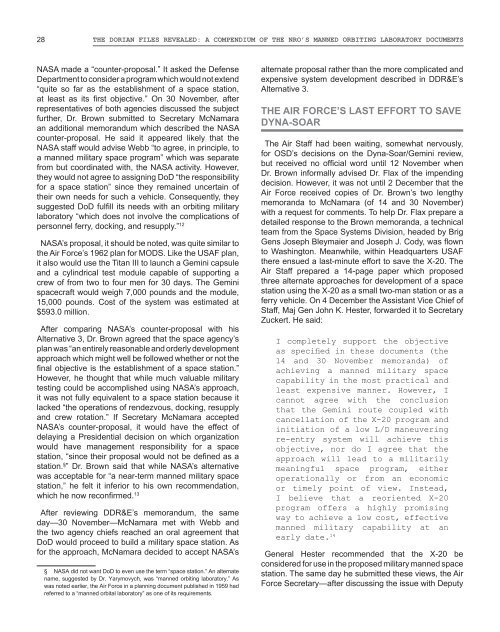NRO-MOL_2015
You also want an ePaper? Increase the reach of your titles
YUMPU automatically turns print PDFs into web optimized ePapers that Google loves.
28 The Dorian Files Revealed: a Compendium of the <strong>NRO</strong>’s Manned Orbiting Laboratory Documents<br />
NASA made a “counter-proposal.” It asked the Defense<br />
Department to consider a program which would not extend<br />
“quite so far as the establishment of a space station,<br />
at least as its first objective.” On 30 November, after<br />
representatives of both agencies discussed the subject<br />
further, Dr. Brown submitted to Secretary McNamara<br />
an additional memorandum which described the NASA<br />
counter-proposal. He said it appeared likely that the<br />
NASA staff would advise Webb “to agree, in principle, to<br />
a manned military space program” which was separate<br />
from but coordinated with, the NASA activity. However,<br />
they would not agree to assigning DoD “the responsibility<br />
for a space station” since they remained uncertain of<br />
their own needs for such a vehicle. Consequently, they<br />
suggested DoD fulfill its needs with an orbiting military<br />
laboratory “which does not involve the complications of<br />
personnel ferry, docking, and resupply.” 12<br />
NASA’s proposal, it should be noted, was quite similar to<br />
the Air Force’s 1962 plan for MODS. Like the USAF plan,<br />
it also would use the Titan III to launch a Gemini capsule<br />
and a cylindrical test module capable of supporting a<br />
crew of from two to four men for 30 days. The Gemini<br />
spacecraft would weigh 7,000 pounds and the module,<br />
15,000 pounds. Cost of the system was estimated at<br />
$593.0 million.<br />
After comparing NASA’s counter-proposal with his<br />
Alternative 3, Dr. Brown agreed that the space agency’s<br />
plan was “an entirely reasonable and orderly development<br />
approach which might well be followed whether or not the<br />
final objective is the establishment of a space station.”<br />
However, he thought that while much valuable military<br />
testing could be accomplished using NASA’s approach,<br />
it was not fully equivalent to a space station because it<br />
lacked “the operations of rendezvous, docking, resupply<br />
and crew rotation.” If Secretary McNamara accepted<br />
NASA’s counter-proposal, it would have the effect of<br />
delaying a Presidential decision on which organization<br />
would have management responsibility for a space<br />
station, “since their proposal would not be defined as a<br />
station. § ” Dr. Brown said that while NASA’s alternative<br />
was acceptable for “a near-term manned military space<br />
station,” he felt it inferior to his own recommendation,<br />
which he now reconfirmed. 13<br />
After reviewing DDR&E’s memorandum, the same<br />
day—30 November—McNamara met with Webb and<br />
the two agency chiefs reached an oral agreement that<br />
DoD would proceed to build a military space station. As<br />
for the approach, McNamara decided to accept NASA’s<br />
§ NASA did not want DoD to even use the term “space station.” An alternate<br />
name, suggested by Dr. Yarymovych, was “manned orbiting laboratory.” As<br />
was noted earlier, the Air Force in a planning document published in 1959 had<br />
referred to a “manned orbital laboratory” as one of its requirements.<br />
alternate proposal rather than the more complicated and<br />
expensive system development described in DDR&E’s<br />
Alternative 3.<br />
The Air Force’s Last Effort to Save<br />
Dyna-Soar<br />
The Air Staff had been waiting, somewhat nervously,<br />
for OSD’s decisions on the Dyna-Soar/Gemini review,<br />
but received no official word until 12 November when<br />
Dr. Brown informally advised Dr. Flax of the impending<br />
decision. However, it was not until 2 December that the<br />
Air Force received copies of Dr. Brown’s two lengthy<br />
memoranda to McNamara (of 14 and 30 November)<br />
with a request for comments. To help Dr. Flax prepare a<br />
detailed response to the Brown memoranda, a technical<br />
team from the Space Systems Division, headed by Brig<br />
Gens Joseph Bleymaier and Joseph J. Cody, was flown<br />
to Washington. Meanwhile, within Headquarters USAF<br />
there ensued a last-minute effort to save the X-20. The<br />
Air Staff prepared a 14-page paper which proposed<br />
three alternate approaches for development of a space<br />
station using the X-20 as a small two-man station or as a<br />
ferry vehicle. On 4 December the Assistant Vice Chief of<br />
Staff, Maj Gen John K. Hester, forwarded it to Secretary<br />
Zuckert. He said:<br />
I completely support the objective<br />
as specified in these documents (the<br />
14 and 30 November memoranda) of<br />
achieving a manned military space<br />
capability in the most practical and<br />
least expensive manner. However, I<br />
cannot agree with the conclusion<br />
that the Gemini route coupled with<br />
cancellation of the X-20 program and<br />
initiation of a low L/D maneuvering<br />
re-entry system will achieve this<br />
objective, nor do I agree that the<br />
approach will lead to a militarily<br />
meaningful space program, either<br />
operationally or from an economic<br />
or timely point of view. Instead,<br />
I believe that a reoriented X-20<br />
program offers a highly promising<br />
way to achieve a low cost, effective<br />
manned military capability at an<br />
early date. 14<br />
General Hester recommended that the X-20 be<br />
considered for use in the proposed military manned space<br />
station. The same day he submitted these views, the Air<br />
Force Secretary—after discussing the issue with Deputy

















